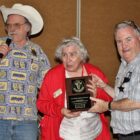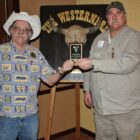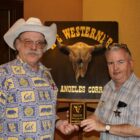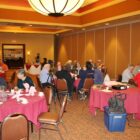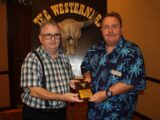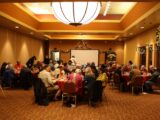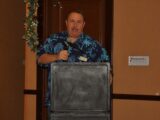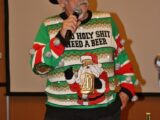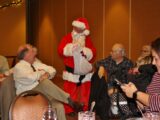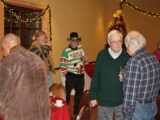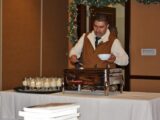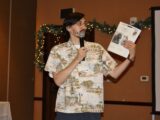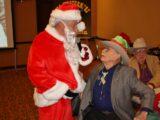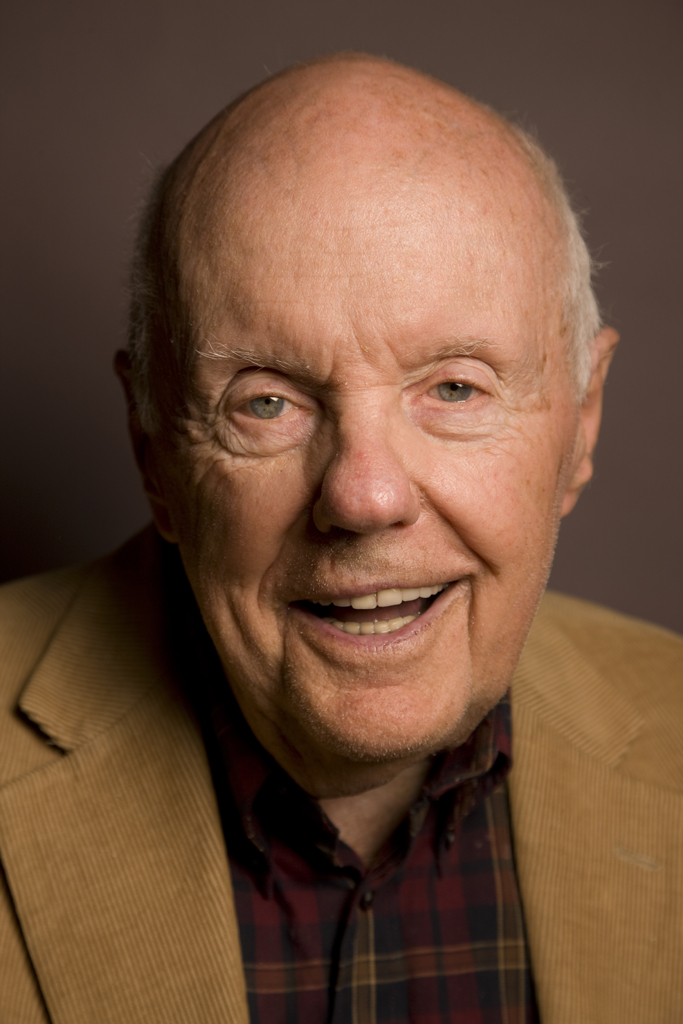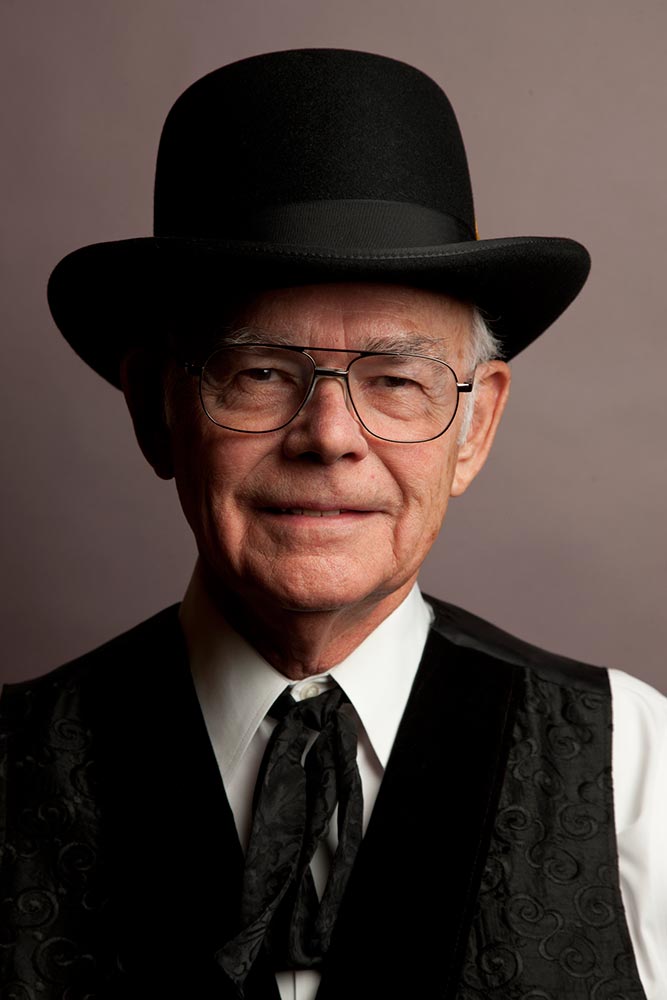Roundup: February 8 2023
WLAC Los Angeles Corral 02.08.23 RoundUp Flyer
Roundup Synopsis
Taken From Branding Iron 309 Winter 2023.
Firearms history through the lens of multiple generations of shooting Dillons. That was our treat in February, as the L.A. Corral’s own Dr. Brian Dillon regaled attendees with a swift, yet detailed, overview of the “shootin’ irons” of Western American history. From the smooth-bore matchlocks of Spanish first contact, to the modern, rifled auto-loaders of the 20th century, the guns that won the West ranged far beyond just the famed 1873 Winchester. We were pleasantly reminded of this fact by the variety of arms, and the folks who wielded them, presented by our eminently qualified former sheriff, and firearms instructor, Brian Dillon.
The aforementioned matchlocks may have been the first firearms present on the continent, but as Spain decided to leave, and stay gone, for a few centuries after their initial introduction in the North, these early irons had no impact on the history of the American West. Rather it was the muskets and rifles of the late 18th and early 19th centuries that first ventured into the West. Lewis and Clark’s expedition made use of later flintlock technology on their epic foray into the new American frontier; the first significant use of firearms west of the Mississippi.
Intrepid trappers, late of the old frontiers in what we now call the Southeast, were among the first to put long irons to use in the further reaches of the West. American adventurers in these early days preferred Pennsylvania rifles, while Canadians pushing west were more known for their use of smooth-bore muskets. The newly-invented percussion cap was too expensive and scarce to be of much utility in the unsettled country, and flintlocks remained in significant use by self-reliant types well into the middle of the 19th century.
The Gold Rush created a huge demand for iron in California, particularly of the defensive variety (after all, nobody will protect your claim but you). Use of the percussion cap quickly made revolvers the standard sidearm of every hunter, trapper, and miner in the rough new country. Perhaps the most iconic arm of the Gold Rush was the 1851 Colt Navy revolver. Six shots ready at the hip were invaluable in this lawless land.
The next major development in firearms was the metallic cartridge. Waterproof and durable, it made reloading a snap, and allowed for reliable mechanisms beyond the revolving cylinder to be used in chambering rounds. One such mechanism was the unforgettable lever action. Patented in 1854 by the Volcanic Repeating Arms Co., it evolved into the action used in the Winchester Model 1873, fabled as “The Gun that Won the West.”
Smokeless powder followed as the next significant leap in the technology of shooting irons, and its introduction heralded the end of the Old West. The Krag-Jorgensen was the first gun adopted by the U.S. military to utilize smokeless powder. There was no turning back from here, and on came the 1903 Springfield of WWI fame, followed by the Colt M1911. A thoroughly modern selfloading pistol, the 1911 represented the end of Old West arms, as by the time of its adoption, the West had largely been won.
The history of the American West can be described fairly thoroughly by telling the history of its weapons. Likewise, the history of American firearms can be largely understood through examination of our country’s westward expansion. And to have those descriptions provided by a compatriot whose ancestors were present on both avenues of that historical journey is a privilege we Westerners should relish. Many thanks to Brian for this presentation.
— Alan Griffin
Photos from the Roundup
Roundup: January 11 2023
Westerners-January-11-Roundup-Flyer
Roundup Synopsis
Taken From Branding Iron 309 Winter 2023.
The Ronald Reagan Presidential Library and Museum is located on a steep hill through the Santa Susana Pass in beautiful Simi Valley, California. It began its mission in 1991 to preserve all of Ronald Reagan’s presidential and personal belongings. The Reagan Library and Museum’s claim to fame is the Air Force One Boeing 707 that former President Reagan himself flew on. The speaker at the Westerners’ January 2023 Roundup, Supervisory Archivist Ira Pemstein, provided a unique insiders’ perspective into the workings of this remarkable institution.
The presidential library system developed gradually over time. Initially, presidential records were a former president’s personal property after his tenure of office, unless voluntarily given to the government as a deed of gift. The handling of records became more formalized with the Presidential Libraries Act of 1955. This act meant that once a president constructed his own building, the National Archives could donate the former president’s work to the library. The second law which came in 1978 was the Presidential Records Act, which specifically required all of former President Richard Nixon’s records to remain in Washington D.C., and not be taken anywhere outside of fifty miles from the capital. The Presidential Records Act also transferred ownership of all documents acquired or created during a presidential term to the federal government, to be managed by the National Archives. Ronald Reagan was the first president to be affected by this law, and all the libraries since Reagan have fallen under the Presidential Records Act.
The Freedom of Information Act allows the public to request specific documents from the Ronald Reagan Presidential Library. Most of the records predate the internet and are paper-based, and have yet to be digitized. Some of the archives are preserved in airtight containers and folders, or are refrigerated. Everything mentioned about the president by the three major broadcasting networks were recorded by the White House, including all the debates, campaign events, and Bob Hope specials. The Audio-Visual Archivist oversees photographs, film reels, and audio and video cassettes. The original formats can be viewed on VHS players and film projectors, which are preserved just as carefully as the forty-year-old media that they play.
The Ronald Reagan Presidential Library has 65 million pages of documents that cover Reagan’s entire life, as well as two-thirds of his career in Hollywood and his term as the Governor of California. The family-operated Ronald Reagan Foundation supplements areas that the federal government cannot, because the material from before and after his presidency does not belong to the federal government. Here is where the Reagan Foundation and the federal government come together. The Reagan family has custody and ownership of the pre- and post-presidential items that are housed at the Ronald Reagan Library and the federal government serves them to the public with the family’s permission.
— Darran Davis
Roundup: December 14, 2022
WLAC Los Angeles Corral 12.14.22 RoundUp Flyer
Roundup Synopsis
Taken From Branding Iron 309 Winter 2023.
December’s Roundup saw the L.A. Corral welcome guest speaker Steve Lech as he took us back almost a hundred years before tens of thousands of people flocked to the Coachella Valley for the biggest music festival in the world. Mr. Lech introduced us to a woman named Susie Keef Smith (1900- 1988), who created photographic postcards of this majestic California desert landscape.
Susie’s love for photography began as a child when she contracted polio at the age of twelve. Her uncle gifted her a large format camera to use while she was confined to a wheelchair. Through perseverance and to doctors’ amazement, she began to walk again. In 1926 with encouragement from her father, Susie became the postmaster of Mecca, California. During the 1920s many Americans had an image of the California deserts as desolate wastelands with no vegetation. This is why they were commonly known as the “Devil’s Garden.” Most people were unaware of the attractions of the Joshua trees, or the dazzling Salton Sea. Susie began to take photographs of the desert landscape which propelled her to the forefront of the golden age of postcards.
During this era Susie encouraged people to travel out west to see the California Desert for themselves. Susie captured photos for postcards by traveling through the desert on a Ford Model T Truck, that was given to Susie by her father on one condition: that she disassemble the vehicle and put it back together again. This she accomplished, and it started on the first crank, proving her skills as a motorist.
Photographic postcards were great for advertising the land and for people to write to each other. This form of postcards created a medium that encouraged people to venture out to the California desert. The routes Susie chose to photograph were attractive to travelers because this was during the time the Colorado River Aqueduct was being built. The aqueduct channeled water through the desert thus enabling desert communities to become popular vacation destinations. The best-known example was Palm Springs. Smith took pictures of the aqueduct construction workers and their equipment. Susie’s photos allowed people to visually grasp the mystic beauties of the desert landscape. A large number of the locations Susie photographed are now part of the Coachella
Valley Preserve.
— Darran Davis
Photos from the Roundup
Living Legend No. 53 John W. Robinson
John Wesley Robinson (1929-2018) was born in Long Beach, California. He attended the University of Southern California, and graduated in 1951. John did his military service in the U.S. Army during the Korean War, then after demobilization began to contemplate what to do with his life, and how he could make a living combining his his favorite subject, history, with his favorite pastime, hiking and mountain climbing. Much later, he went to grad school at California State University, Long Beach, where in 1966 he earned an M.A. Degree in History. John taught history for 35 years at the grade school and junior high school level, the final 32 years within the Newport-Mesa Unified School District of Orange County.
John W. Robinson was the Hiking Historian, a modern-day John Muir. He was equally at home trudging towards some mountaintop as he was in the research library. He climbed and took detailed notes on dozens of the tallest peaks in the North American West, and in Canada, Alaska, and Mexico. His love of the outdoors was nurtured as a child through family camping trips to Yosemite and YMCA summer camps in the San Gabriel Mountains during the 1930s. By the mid-1950s Robinson was leading Sierra Club hikes to and through California’s Sierra Nevada, as well as lower-elevation ranges closer to Los Angeles. He was a mainstay of the Southern California Sierra Club, and was repeatedly commended by that organization for his outstanding dedication to the protection and preservation of the Golden State’s natural wonders, especially through his unique talent of enhancing public awareness of them. In 1959 Robinson was given the Sierra Club’s Hundred Peaks Award in recognition of having climbed that many mountains in three different New World countries. Thirty-two years later, he was honored again by the Sierra Club’s Outings Service Award, for having introduced so many neophyte hikers and backpackers to the great outdoors.
John was the universally-acknowledged master of historical writing about the mountains, deserts, and all the lightly-populated wild places that still exist in Southern California. His publications were the antidote to the too-narrow, exclusively urban, writing of most academic historians who seldom venture beyond the Los Angeles city limits. Robinson understood the importance of topography and cartography to accurate historical writing better than any cellar-dwelling urban historian or Ivory Tower shut-in who remained innocent of in-person exposure to any of the places they wrote about. John also reveled in, as the old saying goes, “all of the -ologies.” In addition to his primary devotion to history, he was as knowledgable about the geology, climatology, botany, zoology, etymology, ethnology and archaeology of his beloved Southern California as were most experts in every one of these varied fields. Robinson considered familiarity with the “-ologies” as necessary for understanding history as most chairborne academics did political science, or economics.
John W. Robinson published a remarkable number of full-length books and articles on the history of out-of-the way places few Southern California city-dwellers were familiar with. He kicked off his writing career with Camping and Climbing in Baja California (1967), which was followed by Trails of the Angeles (1971). This handy hiking and back-packing guide has been in print for more than 50 years, and has sold more than 80,000 copies. It is one of the books, quite literally, on the shelf of every Boy Scout and Sierra Club member in Los Angeles County. Robinson indulged his own personal fascination with mining and prospecting history with Mines of the East Fork (1972), the first of what would be several books on the old mines of Southern California. This was followed, that same year, by yet another “trail” book, San Bernardino Mountain Trails (1972), and then by The Mount Wilson Story (1973), Mines of the San Gabriels (1973), and Mines of the San Bernardinos (1977). The books that John Robinson was most famous for, and for which he truly deserves a permanent spot atop literary Mount Olympus, are his beautifully-illustrated, large-format “mountain trilogy,” The San Gabriels (1977), The San Bernardinos (1989), and The San Jacintos (1993).
Even while writing one hiker’s guide or magnificent summary of the cultural and natural history of yet another Southern California mountain range after another, John contributed article after article to the Branding Iron, the Los Angeles Corral of Westerners International quarterly publication. He wrote about the old Ridge Route over the mountains from Los Angeles to the San Joaquin Valley, about the old Plank Road through the desert of Imperial County, and about what happened in and around Los Angeles during the Civil War, to name but a few of his many and varied Branding Iron articles. Robinson was also a mainstay of the California Territorial Quarterly, and its most prolific Southern California contributor. During the 25 years of this wonderful quarterly’s existence, John published an unsurpassed 44 articles on Southern California historical topics within its pages.
Not just the most prominent Sierra Clubber of Southern California, John Robinson was also a member of the Oregon-California Trails Association, and a founder of the California chapter of the Old Spanish Trail association. John won the Donald H. Pflueger Award from the Historical Society of Southern California, twice, in 1992 and in 1998, and the Scholastic Authorship Award of the Conference of California Historical Societies in 2003. He was made a Fellow of the Historical Society of Southern California in 2005 for “Exceptional lifetime achievements that have brought distinction to history.”
John W. Robinson was one of the most dedicated members of Westerners International you could ever hope to meet. He belonged to and was active within three different corrals, Los Angeles, Huntington, and San Dimas, and served as Sheriff of the Los Angeles Corral in 2001. Robinson won the Westerners International Coke Wood Award for his historical writing three times, in 1990, 1992, and 1995. In recognition of his prolific output as an historian, and his many and varied contributions to all three of the corrals he honored with his presence, John W. Robinson was made Westerners International Living Legend No. 53 in 2010.
It is hard to describe John W. Robinson without recourse to superlatives. Olympian is the adjective that comes most readily to mind, not only for his influential and inspirational publications, but also in its original, elevational, context. No Southern California historian exemplified the old saying “Without Geography, you are nowhere” better than he did. Place names held a special fascination for him, but whereas most of his urban-dwelling peers only studied the origins of the names of towns and cities, John delighted in revealing the sources of the names of creeks, mountain passes, overgrown alpine meadows, and abandoned wagon roads. He linked each place to the long-dead people, Indians and settlers alike, who named them, passed through or used them, or lived near them. And he was able to do this because he went to every last place he ever wrote about, no matter how isolated, nor difficult of pedestrian access.
John Robinson was a kind, gentle, and generous soul. Modest, humble, and immensely likable, he was always willing to share his knowledge with friends, students, fellow historians, even total strangers he met along the trail or in conference rooms. He was always willing to review and red-ink drafts given him by younger writers, and to encourage them in their efforts: the writer of this brief summary was one such admirer, and is still grateful for the time and thought he put into pre-publication reviews of his own research write-ups. Only the most productive writers know that every minute spent working on a draft written by someone else is a minute stolen from the work you should be doing on your own drafts, but John was never too busy to ignore the swarm of younger writers clamoring for his editorial suggestions and, of course, his approval. He could correct the most embarrassing error so avuncularly that you were left brimming with pride that he cared enough about your own work to help you get it right.
Late in life, John donated his extensive collection of books, maps, manuscripts, and drafts to the Los Angeles Corral’s archive in the Special Collections division of the University of Southern California Library. As he grew older, and the robust young body that had conquered so many tall mountains began to lose its battle against old age, he had to stop hiking, and then driving, but he never lost his wonderful sense of humor nor his upbeat outlook on life. John W. Robinson may now be gone, but his writing lives on. There is no doubt whatsoever that his wonderful literary legacy will continue to inspire and enchant hikers no less than historians in all of the places he wrote about. And there is also no doubt that future generations not yet born will, in years to come, still turn to John’s books, articles, and trail guides. These will continue to be the best pathway for escaping the claustrophobia that so plagues the overcrowded City of the Angels and its environs. Nor is there any doubt that once these future Angeleños have been guided by John W. Robinson’s writing to the wonderful wild lands that can provide solace for their minds, spirits, and bodies, they will thank him, as past generations have always done, for so generously sharing his wisdom.
By Brian Dervin Dillon, Ph.D., 2018, revised 2022.
Living Legend No. 63 – Jerome R. (Jerry) Selmer
Jerry Selmer (1933-2018) joined the Los Angeles Corral of Westerners International in the Fall of 1975, at the invitation of former Sheriff Sid Platford. Long before that, however, he was a friend and admirer of Homer Britzman. Britzman founded the Los Angeles Corral in 1946, and lived in Charlie Russell’s old house, surrounded by wonderful works of art by that brilliant Western artist. Jerry was Britzman’s neighbor, and it was while visiting the Britzman/Russell house that the “western bug” first bit the much younger Selmer.
Jerry Selmer was a 3rd generation Californian who always made his home in the Los Angeles area. How his family got to the Golden State is a riveting tale still awaiting publication, involving final farewells from the 1862 Shiloh battlefield written in human blood, and a shipwreck, marooning, and miraculous rescue from the freezing wastes of Tierra del Fuego. Hope springs eternal that even though Jerry has left us, his son John, a second-generation Los Angeles Corral member and former Sheriff, may yet be motivated to write down his remarkable family history and publish it.
Jerry attended Pasadena City College, then UCLA, where he graduated with a B.A. in Public Administration in 1955. Also in the ROTC, he traded his cap and gown for a 2nd Lieutenant’s uniform in the U.S. Army. After promotion to 1st Lieutenant, Selmer finished his military obligation in the California National Guard as a Captain. As an officer he became proficient as an instructor of enlisted personnel, a skill that was seamlessly transferred into civilian life. Jerry worked for the City of Los Angeles, rising up through the ranks over a 31-year career culminating in the post of Assistant City Administrator, the Mayor’s “go to” guy for 42,000+ city employees and 25 separate Unions. Here again, Selmer’s mediation skills spared one Los Angeles Mayor after another a great many headaches, and aided the smooth functioning of America’s second-largest city.
Selmer served in many different Los Angeles Corral positions, including Wrangler and Registrar, mentored by former Sheriffs Everett Hager and Elwood “Dutch” Holland, before becoming Deputy Sheriff in 1984, and Sheriff in 1985. During his tenure as Sheriff, Jerry planned the Corral’s 40th anniversary, and served as the chair of the committee that ensured that this important landmark was celebrated to the pleasure and satisfaction of all. So successful was he in this effort that Jerry was called back twenty years later to plan and execute the Corral’s 60th Anniversary, and, most recently, in 2016, its 70th. Jerry Selmer also personally recruited at least a half-dozen new members into the Los Angeles Corral, including his son John, who became Sheriff in 2016, and Jim Macklin, the hardest-working Keeper of the Chips our Corral has ever had, who also later moved on into the Sheriff’s slot.
Jerry published articles in the Branding Iron, including an insightful review of our Corral’s own history. He also contributed dozens of insightful book reviews to that same quarterly journal, which for nearly forty years have sent readers off in search of worthwhile, recently published, books on Western Americana. Selmer was also responsible for another kind of writing, the revision of the Corral’s Range Rules. This task could only have been done with the aid of another one of Jerry’s greatest gifts: his tried and true ability to find consensus amongst the bewildering variety of opinions generated within any large voluntary association such as the Westerners.
Selmer was a talented and captivating public speaker. He was the invited lecturer to the Los Angeles Corral at its monthly round-ups on topics as diverse as The History of the Southwest Museum and Charles Lummis, The Civil War in the West, Chief Joseph of the Nez Perce, and the Penitentes of New Mexico. His research interests were broad, incorporating western mining, ghost towns, American Indian culture history, and Western American art.
Jerry and his beloved wife Doris were married for 62 happy years. Very much a team, together they were active not only in the Westerners, but also the Zamorano Club, the Friends of Arcadia Public Library, the Arcadia Historical Society, the Miniature Book Society, and, the San Dimas Festival of Western Art, an annual event where Jerry served as Judge. The Selmers for more than six decades also engaged in their passion for travel throughout their beloved West, not just within the United States, but also in Canada and Mexico, usually far from the beaten track, seeking out remnants of the past still lingering into the present.
Upon his retirement from the City of Los Angeles, Jerry became the Executive Director of the Southwest Museum, the oldest and most prestigious museum of the Los Angeles Area. He guided it for four years through its most difficult period over the century-plus of its existence. Long before this, however, he exercised his teaching skills within the City of Los Angeles employee training program, mostly in public administration, and then expanded the number and nature of his lectures to include regular presentations at Los Angeles City College, the Southwest Museum itself, and the University of Southern California. Selmer also served on the City of Arcadia Public Library Board, the Friends of Mission San Fernando Archival Center, and as an honored advisor to the City of Los Angeles ’Contracting Procedures.
Jerry Selmer, through his wise counsel and vast experience, mentored a great many Los Angeles Corral members, officers, and Sheriffs, including the writer of this brief summary. His firm hand on the tiller guided our Corral through the rocks and shoals periodically encountered during his more than four decades of active service, and he always brought us through the occasional storms to calm waters. Jerry’s immense contribution to the Los Angeles Corral was recognized in 2018 when he was made the 63rd Living Legend of Westerners International, shortly before he left his many friends and admirers for the final time.
By Brian Dervin Dillon, Ph.D., 2017, revised 2022.


